- News
- Reviews
- Bikes
- Components
- Bar tape & grips
- Bottom brackets
- Brake & gear cables
- Brake & STI levers
- Brake pads & spares
- Brakes
- Cassettes & freewheels
- Chains
- Chainsets & chainrings
- Derailleurs - front
- Derailleurs - rear
- Forks
- Gear levers & shifters
- Groupsets
- Handlebars & extensions
- Headsets
- Hubs
- Inner tubes
- Pedals
- Quick releases & skewers
- Saddles
- Seatposts
- Stems
- Wheels
- Tyres
- Tubeless valves
- Accessories
- Accessories - misc
- Computer mounts
- Bags
- Bar ends
- Bike bags & cases
- Bottle cages
- Bottles
- Cameras
- Car racks
- Child seats
- Computers
- Glasses
- GPS units
- Helmets
- Lights - front
- Lights - rear
- Lights - sets
- Locks
- Mirrors
- Mudguards
- Racks
- Pumps & CO2 inflators
- Puncture kits
- Reflectives
- Smart watches
- Stands and racks
- Trailers
- Clothing
- Health, fitness and nutrition
- Tools and workshop
- Miscellaneous
- Buyers Guides
- Features
- Forum
- Recommends
- Podcast
review
£2,299.00
VERDICT:
Rotor's 1x13 makes 1x much more usable but the groupset is let down by poor shifting performance
Weight:
2,336g
Contact:
At road.cc every product is thoroughly tested for as long as it takes to get a proper insight into how well it works. Our reviewers are experienced cyclists that we trust to be objective. While we strive to ensure that opinions expressed are backed up by facts, reviews are by their nature an informed opinion, not a definitive verdict. We don't intentionally try to break anything (except locks) but we do try to look for weak points in any design. The overall score is not just an average of the other scores: it reflects both a product's function and value – with value determined by how a product compares with items of similar spec, quality, and price.
What the road.cc scores meanGood scores are more common than bad, because fortunately good products are more common than bad.
- Exceptional
- Excellent
- Very Good
- Good
- Quite good
- Average
- Not so good
- Poor
- Bad
- Appalling
There's a lot to like about Rotor's 1x13 groupset but ultimately it falls down on the shifting performance, which just isn't as good as Shimano, SRAM or Campagnolo. You're also going to need a new rear wheel to accommodate the 13-sprocket cassette.
- Pros: Wide 1x range, lightweight, sealed system
- Cons: Need new wheels, shifting quality
In its favour is the best 1x drivetrain I have yet used. Going to 13 sprockets is a big step towards smoothing out the compromise of a 1x11 setup. The range is ample and the progression is almost seamless, with very few ugly steps between key gears to upset your beautiful cadence.
The fourth groupset
Shimano, SRAM and Campagnolo have long been the major players in the groupset market, but in 2016 a small Spanish company best known for CNC machined cranks, chainrings and power meters joined the fray. Rotor's Uno featured an innovative hydraulic shifting system that ensured it stood out from other groupsets which use either a gear cable or electronic wire.
Rotor has since developed that first groupset into 1x13, taking the fundamental hydraulic technology and finessing it into a dedicated 1x groupset with an all-new rear derailleur and 13-speed cassette.
It was partly fuelled by mixed reviews on the original Uno groupset and many complaints levelled at the front derailleur. Getting rid of the front mech entirely has been the solution; that and developing a range of 13-speed cassettes to suit a wide range of applications.
Why 13-speed?
Because you get almost the same spread of gears as a regular double, with the range and smooth gear progression to keep within the optimal cadence range the whole time.
There has been lively debate in recent years about one chainring versus two, with the rise of 1x causing much angst among traditionalists. There are many well-advertised benefits to 1x but also inherent flaws caused by removing the front mech, namely range and cadence jumps because of big sprocket changes.
Rotor's 1x13 goes a long way to addressing this issue by getting very close to the 14 actual usable gears on a typical double setup, once you remove the duplicates.
Rotor has also spent time using data from pro cyclists to develop a range of cassettes, from 10-36 to 10-52, with a narrower band in higher gear ratios and a wider spread as you get lower. So there should be no downside in pedalling efficiency.
As a result, 1x13 has a 390% range with a 50-tooth chainring and a 10-36t cassette, as opposed to 346% with a 53/39 and 11-28 setup. The maximum range with a 10-52 cassette is a whopping 520%.
New cassettes means new wheels. Rotor is actually using Shimano's HG splined freehub but it has been moved inboard by 3mm. That allows Rotor to use a new two-part lockring and a 10-tooth sprocket that sits outboard of the freehub. It is, though, using regular 12-speed chains since the cassette uses 12-speed spacing.
Why hydraulic shifting?
Because, why not? Rotor could have come to market with another gear cable operated or electronic groupset, but instead it had the audacity to develop a hydraulic groupset.
And not just because it's different, but because a hydraulic groupset does offer numerous benefits. It's a completely sealed system, so apart from the initial bleed should never really need much maintenance. There are also no batteries to charge and no motors to potentially fail.
The groupset uses a 3mm hydraulic hose and indexing is in the derailleur, so it should never go out of alignment, just like an electronic groupset. A small button on the mech will dump the system into the highest gear, so there's no need to click through all the ratios to get the mech in the best position to release the wheel.
The lack of motors and batteries also helps to keep the weight low – Rotor claims 2,336g with a 10-36 cassette and Aldhu cranks and an uncut chain and hoses. I wasn't able to weigh the groupset on this test bike to verify the claims.
For comparison, a SRAM Force 1 groupset weighs 2,466g, SRAM Red eTap AXS is 2,518g and Shimano Dura-Ace Di2 is 2,389g.
Ride impressions…
I managed to spend some time aboard an Argon 18 Dark Matter, a carbon fibre gravel bike with Enve wheels and an 8.3kg weight for the size 56cm I rode.
The groupset comprised a 42t chainring and 10-46 cassette, the so-called 'gravel' configuration of Rotor's new 1x13 groupset. Here's how I got on.
Shifting performance
Even if you're not that used to Shimano, SRAM or Campagnolo, it doesn't take too long to get the hang of operating the shift buttons. Usually a few miles down the road and your brain has memorised the actions of the buttons and you're merrily shifting up and down the cassette.
It's a good start with Rotor's groupset. The single paddle on the right hand shifter works almost identically to SRAM's DoubleTap, a groupset I've long been a fan of and have on two of my personal road bikes. Press to go to a harder gear, press further to go to an easier gear. Simple.
But things get a bit tricky with the Rotor gear lever. The key issue to my mind is the lack of a defined hard click, or thunk, when you've moved it the prescribed amount to initiate a gear change.
The reason for this vagueness is simply because the indexing is built into the derailleur, not the shift lever like other groupsets. There is a click but it's barely noticeable either through your finger or ears. You really have to feel for the soft 'indentation' that marks the gear change.
Changes to a smaller sprocket (harder gear) are easier: you only have to move the paddle a little way. Changing to a bigger sprocket (easier gear) is a lot trickier: you have to push past this first click to a vague second click to make the derailleur leap into action.
It gets easier, to a degree. I spent a reasonable amount of time on the bike, more than enough to become familiar and at ease with a new groupset, but I never really gelled with it.
Sometimes I would nail the gear change satisfactorily, but all too often I'd make a hash of it. Changing to an easier gear was often trickier, especially under load, as you might do when suddenly faced with a steep muddy climb and need to get into a low gear pronto for fear of stalling.
Neither is the free lever travel light and silky smooth. There's a fair amount of resistance in it. It feels akin to stirring porridge.
The need to learn how much lever travel is required to change gear, to carefully calibrate your finger to move the chain sweetly across the cassette, might appeal to those who like a challenge, but faced with heavily refined rival groupsets I can't help feeling it's asking too much. A fact that was highlighted after my time with the Rotor-equipped bike when I jumped onto a bike with a mechanical Shimano groupset and the gear change action was so simple, precise, satisfying and easy with every change of sprocket.
Closer to 1x perfection
The range of the test bike groupset – 42 x 10/46 – is roughly equivalent to a 48/33 x 11-36 setup, with the same top and bottom end. This is a good gearing choice for a gravel bike.
As a result, I had no problem getting up the steep climbs I like to suffer up, nor did I feel at any huge disadvantage on descents or fast, flat roads. Whether on muddy trails or smooth roads, I had all the necessary gears with no shortcomings in the available ratios.
Most appreciated were the smooth steps between sprockets when bashing along the road at 25-33kph, with nary a sudden cadence surge or drop encountered over the rolling terrain I largely rode the bike on.
Blindfolded, I reckon I'd be hard pushed to tell the groupset apart from a conventional groupset when it comes to gear choices.
When it came to running the groupset in the extreme gears, the Rotor worked just fine on the steepest climbs or fastest descents. There's a bit more noise from the biggest sprocket, but it generally worked okay.
There will be inevitable questions regarding loss of efficiency. I have no data to answer this question, and Rotor supplies none to quote, so it's something that will need to be independently lab tested to see how it compares to others.
Rotor has added a clutch-style mechanism to the derailleur. Like SRAM and Shimano derailleurs with this technology, it's a key component of a 1x drivetrain, helping to eliminate chain slap and thus prevent the chain coming off the chainring in the absence of a front mech.
Ergonomics and braking
Ergonomics is vital to a groupset. The hoods have to feel nice in the hands, the shift paddle has to feel right under the finger tip, the brake levers need to be easy to reach and feel good in use.
The Rotor 1x13 hoods are mostly good, but could be improved. Use any groupset from Shimano, SRAM or Campagnolo and you'll find the fit, feel and finish to be a very high standard, differences in shapes, sizes and personal preferences notwithstanding.
Rotor's hoods are quite large, but not excessively so. The shape is rather rudimentary, though, and not as sculptured as rival hoods. The rubber material is also quite thin and doesn't fit very securely onto the actual hood, resulting in a less than positive experience in the hand. They're not uncomfortable, just not the nicest.
The rubber hood material is also a bad fit on the body of the lever. It moves about during use, dramatically so under heavy braking when clenching the hoods tightly. At this price and when faced with such established groupsets, it needs to be better.
This hasn't been a long-term test, but already the rubber material is showing signs of wear at its thinnest along the top of the handlebar. It doesn't bode well for longevity.
The brake levers are a nice shape, though, and easy to reach from the hoods or drops. The shift paddle is a generous size and easy to push, but it could benefit from some dimples or texture to enhance the feel, especially when using gloves.
Actual braking power is remarkably good, and easily the equal of Shimano or SRAM brakes. They feel strong and reassuring during use, with plentiful modulation.
I wasn't able to test the bike on any long mountain descents, but Magura, the German company largely responsible for the brakes, has lots of experience developing bike brakes, which should put any concerns to rest.
Price and value
Rotor 1x13 comes in various versions depending on requirements and budget. It starts at £2,299 with a Rotor aluminium wheelset (not the Enve rims seen here) and rises to £3,999 with upgrades including 2INpower power meter and a carbon wheelset.
For comparison, SRAM Red eTap AXS 1x Disc costs £2,849, or £3,294 with a power meter. Don't forget these prices don't include wheels, so the Rotor groupset isn't actually that bad on paper.
> Beginner's guide to groupsets
Bleed kits aren't included, which seems a bit stingy, so you'll need to factor in another £99 for that too, or get a shop to install it for you.
Being essentially a modular groupset, there's a choice of cassettes to ensure its suitability for everyone from roadies to mountain bikers, ranging from a 10-33 to a massive 10-52 cassette. You can choose round or Q-ring oval chainrings as well, with sizes from 38t to 54t to pick from.
You'll need a new rear hub, as the splined freehub is necessarily different to accommodate the 10t sprocket, so Rotor has developed its own RVOLVER hubs. As this test bike shows, it's possible to build the hubs onto any rims you like. The hubs impressed, with a quick-engaging freehub, but I can't comment on long term durability. Being limited to these hubs will be a potential sticking point for some.
Interestingly, there's a 12-speed upgrade option costing £1,750 which lets you use your current wheels, as the two 11-36 or 11-46 cassettes fit a regular 11-speed freehub. It allows you to invest in Rotor's groupset with the option to upgrade to 13-speed and new wheels at a later date.
Summary
Which leaves me to conclude that, as impressive as the innovation is with Rotor's hydraulic groupset, it's hard to recommend when the shifting just isn't on a par with the main rivals, which is a real shame because I'm all for choice and more challenges to their dominance.
> Your complete guide to Shimano road bike groupsets
> Your complete guide to Campagnolo road bike groupsets
> Your complete guide to SRAM road bike groupsets
If Rotor can just work on the shifting quality I think we're looking at a genuinely exciting addition to the groupset market with numerous benefits. The 1x13 is a triumph and the groupset's most appealing aspect, whether you're already a fan of 1x or have been waiting until this point in its evolution to make the plunge.
Verdict
Rotor's 1x13 makes 1x much more usable but the groupset is let down by poor shifting performance
road.cc test report
Make and model: Rotor 1x13 hydraulic groupset First Ride Review
Size tested: 42 x 10-46
Tell us what the product is for and who it's aimed at. What do the manufacturers say about it? How does that compare to your own feelings about it?
Rotor says: For competitive cyclists who want a light and reliable hydraulic system with an optimised gear sequencing and wheels built for comfort and durability.
1x13 has been designed to strike the perfect balance between lightness, precision and durability with aluminum wheels to withstand the most demanding pedalling conditions.
The ROTOR 1x13 allows for the first time a 1x drive with finest gear steps and maximum flexibility and bandwidth for all purposes!
The 1x13 group offers a unique hydraulic shifting system with a chainring, which is not only very light and low-maintenance, but also offers an extremely reliable shifting performance even under load, which no 2x11/2x12 system can match.
The modular 1x13 system allows an extremely flexible configuration for all applications. A very wide range of different 13 and 12 compartment cassettes with a large number of oval and round 1x Direct Mount chainrings allows the perfect combination of ratios for every situation and challenge!
ROTOR 1x13 brake lever combination
The 1x13 is also compatible with existing ROTOR Uno brake levers, only the left brake lever has to be converted to a brake lever.
Light, robust and low-maintenance
In addition to weight savings, the 1x13 offers an unprecedented level of reliability and low maintenance thanks to a closed hydraulic system. It offers all the advantages of a 1x drive but not only with the full bandwidth of a 2x11 but also allows an optimal cadence through fine gear graduation!
Revolutionary rear derailleur technology
The ROTOR 1x13 is designed around a drive system that consists of a revolutionary rear derailleur design, special 13-speed hubs with optimized wheels and modular cranks or power meters with 1x Direct Mount chainrings.
The precision handcrafted rear derailleur includes not only a clutch to minimise chain impact on 1x drives, but also gear indexing. It can be adjusted between 13 and 12 and is compatible with ROTOR 1x13 road bike brake levers, ROTOR 1x13 triathlon gear levers and the ROTOR 1x13 MTB Schifter.
The technology of the 1x13 rear derailleur is protected from shocks and foreign bodies by a multiple reinforced housing.
Tell us some more about the technical aspects of the product?
From Rotor:
What's included: Right Hand Shifting & Brake Lever, Left Hand Brake Lever, Rear Derailleur, Brake Caliper, Brake Rotors & Hardware, 13 s Cassette, 13s Hubs, 13s Aluminium Wheels, ALDHU Crankset.
Bleed kits not inlcuded..
Weight 1,785g.... includes below components
1x13 groupset including shifters, derailleur, brakes and hydraulic hosing
(Flat mount callipers, uncut hoses: 1,800 mm x 3mm / 1,800 mm x 5 mm / 950 mm x 5mm, 160 mm rotors and all hardware included), 10-36 - 13s cassette, chain (uncut 126L)
Rate the product for quality of construction:
8/10
Rate the product for performance:
6/10
Rate the product for weight (if applicable)
7/10
Rate the product for comfort (if applicable)
7/10
Rate the product for value:
5/10
Tell us what you particularly liked about the product
1x13 works very well, lightweight, no batteries to run out.
Tell us what you particularly disliked about the product
Shifting quality.
Did you enjoy using the product? Some
Would you consider buying the product? Probably not.
Would you recommend the product to a friend? Probably not.
Use this box to explain your overall score
There's lots to like about Rotor 1x13 but the shift quality lets it all down, which is a shame because the 13-speed 1x setup works a treat. Unless you're prepared to learn to live with the tricky shifting, it's hard to recommend.
About the tester
Age: 31
I usually ride: My best bike is:
I've been riding for: 10-20 years I ride: Every day I would class myself as: Expert
I regularly do the following types of riding: road racing, time trialling, cyclo-cross, commuting, touring, mountain biking
David worked on the road.cc tech team from 2012-2020. Previously he was editor of Bikemagic.com and before that staff writer at RCUK. He's a seasoned cyclist of all disciplines, from road to mountain biking, touring to cyclo-cross, he only wishes he had time to ride them all. He's mildly competitive, though he'll never admit it, and is a frequent road racer but is too lazy to do really well. He currently resides in the Cotswolds, and you can now find him over on his own YouTube channel David Arthur - Just Ride Bikes.
Latest Comments
- Terry Hutt 3 hours 24 min ago
I assume you can carry an e-bike battery on the tube if you leave the bike at home. ...
- chrisonabike 4 hours 26 min ago
I love it - it's a roundabout with a sculpture of a roundabout on its desk!
- cmedred 4 hours 27 min ago
From the position of the cyclist when the video starts and the position of the bike later, it looks highly unlikely that the cyclist went "into the...
- Rendel Harris 4 hours 33 min ago
To rhyme with design. I wondered this myself so looked it up a while ago, according to the founder Micki Kozuschek he and his team had a few...
- Rendel Harris 5 hours 27 min ago
It's not being pedantic at all, careless driving is successfully prosecuted (and I have been in court more than once when a driver has been...
- HLaB 5 hours 50 min ago
It's hopefully an urban myth but I heard it was designed that way on purpose, so the cyclepath captured any flooding and the busway would remain clear
- mdavidford 5 hours 53 min ago
I should imagine eating chopsticks anywhere could be potentially rather perilous.
- Rendel Harris 6 hours 11 min ago
When The Badger stopped for protesters (albeit dockworkers rather than farmers) it was their stress gauges rather than his that would have been...
- Eurodolphin 6 hours 56 min ago
Having experienced a brain injury (while my helmet only suffered a little crack) I welcome all this excellent research which looks for ways to...
- mattw 6 hours 59 min ago
Nope. Has anyone ever bought a wheel trim studded with diamonds for their car? Thought not.



















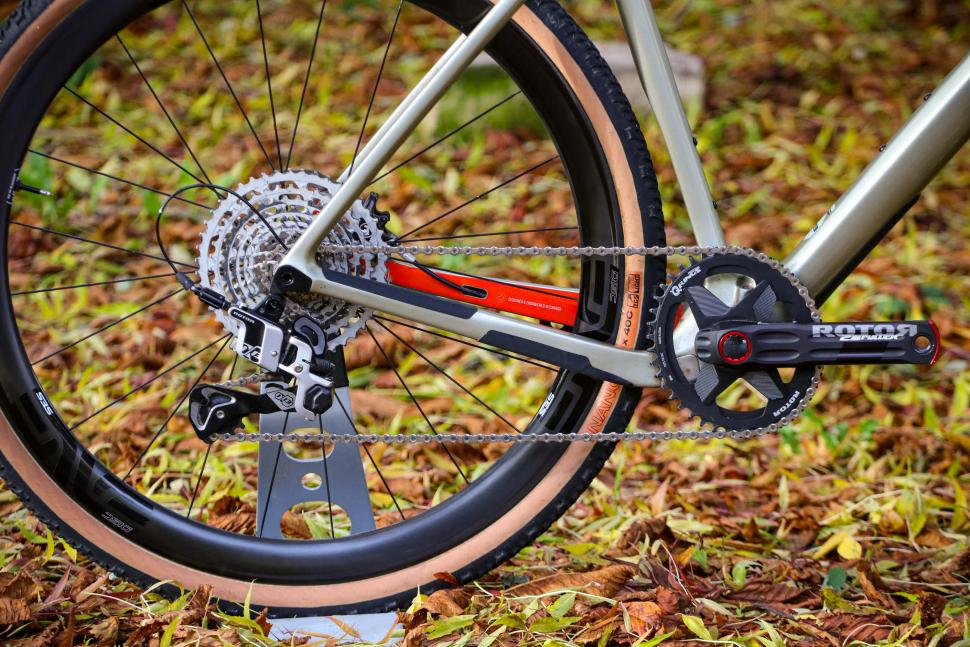

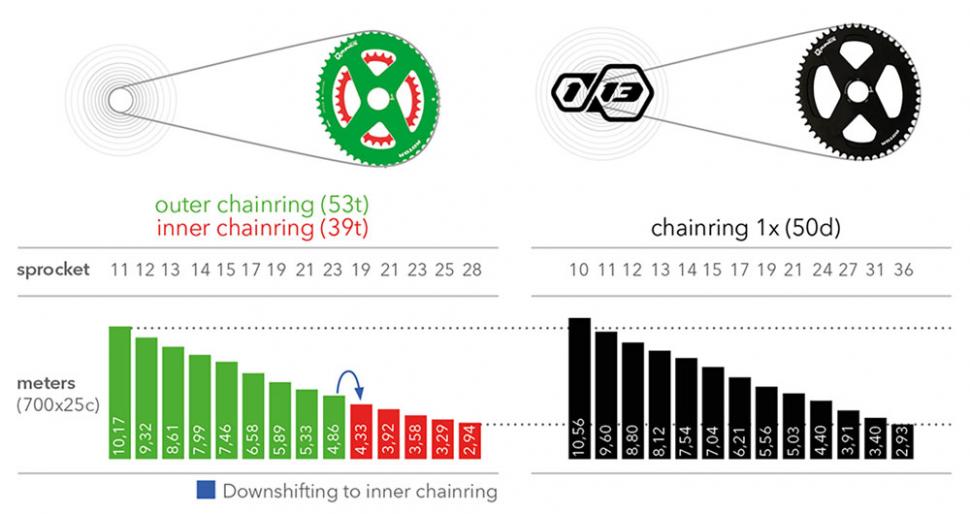



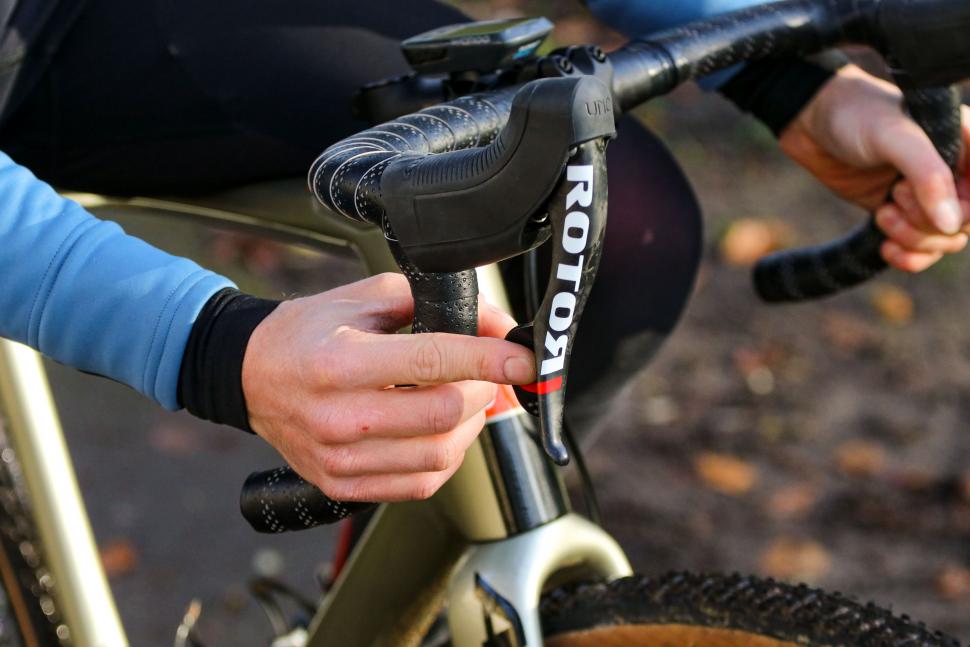
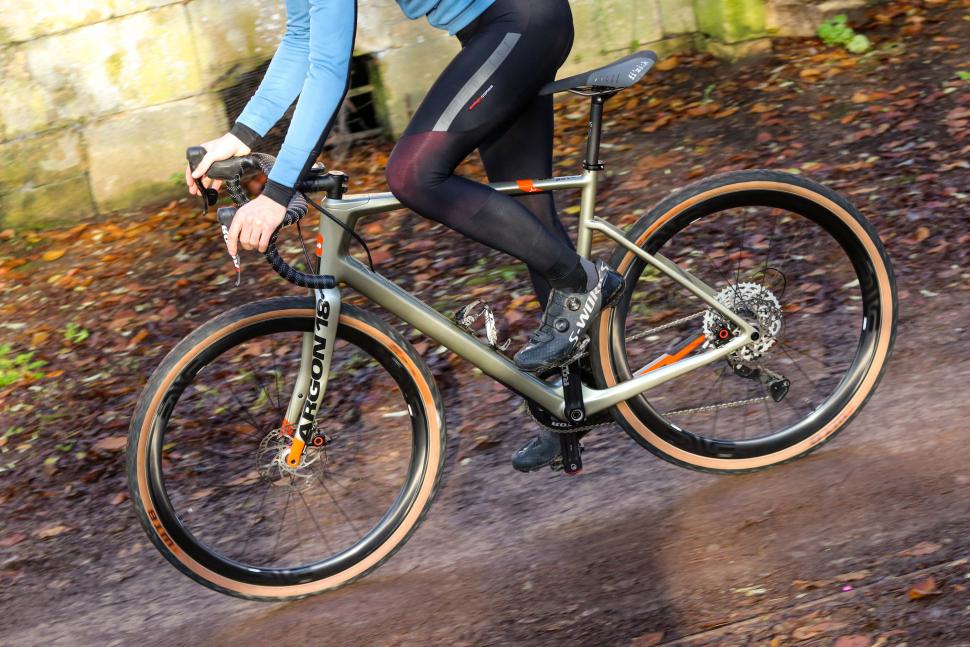
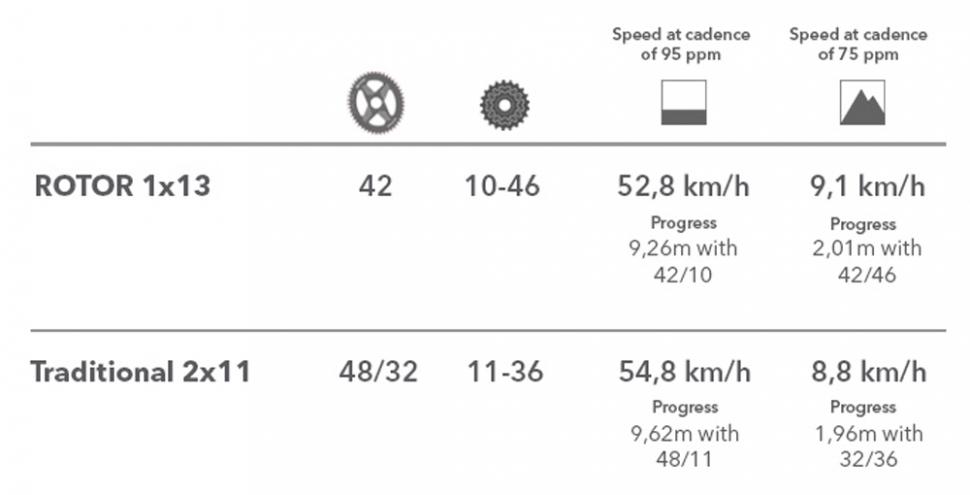
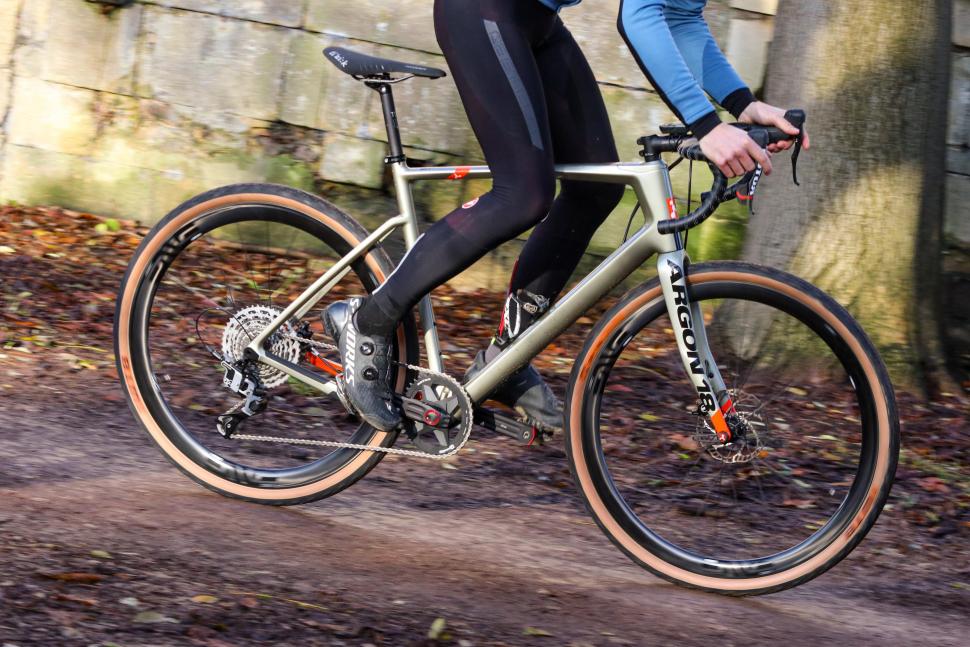


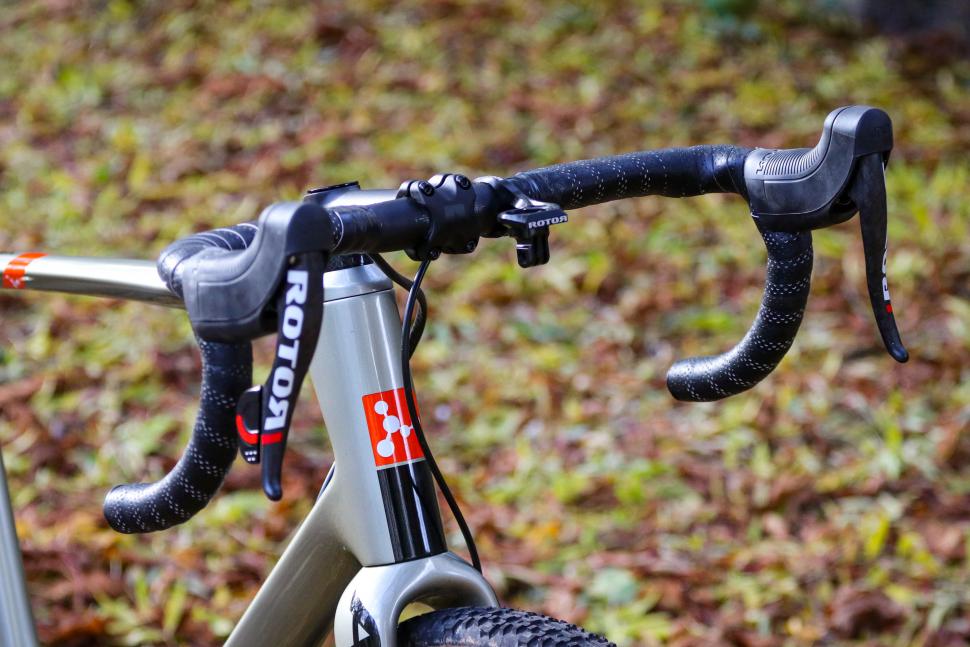

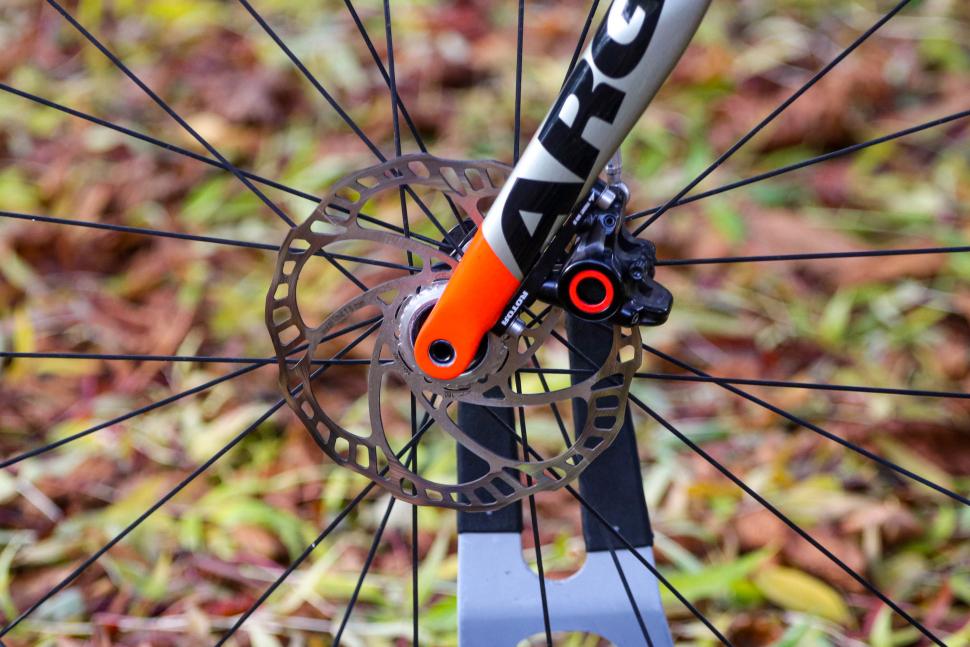
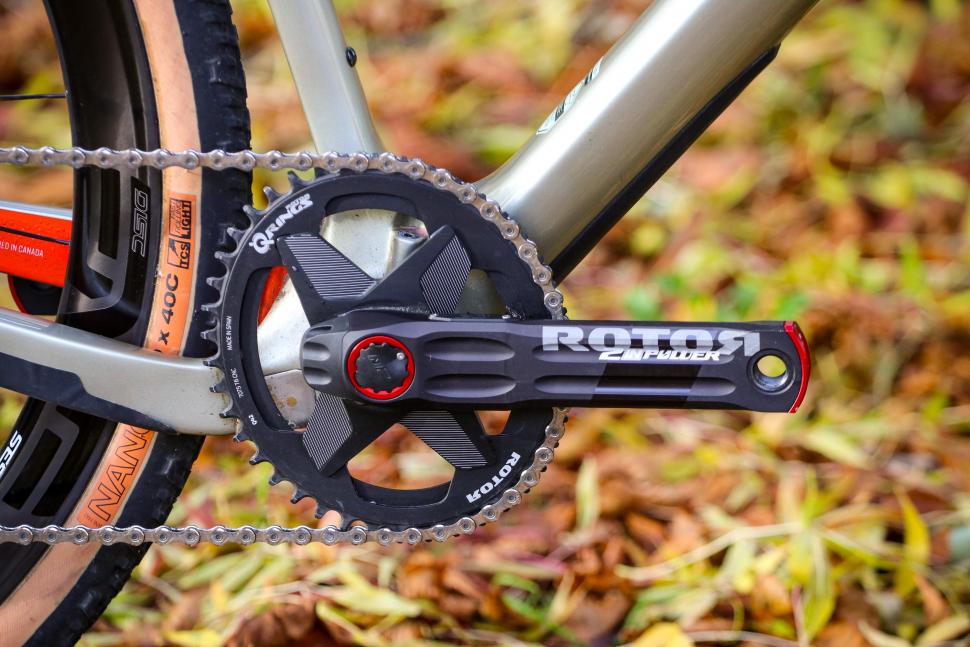



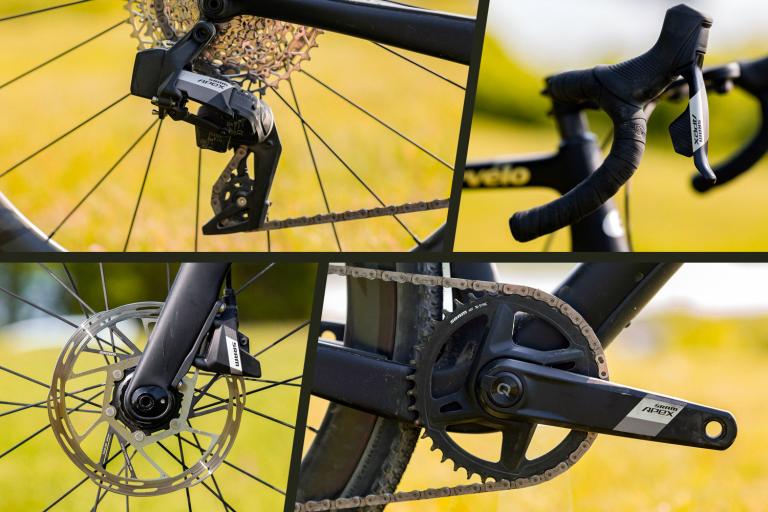
Add new comment
17 comments
A genuine question, is the deraulier sprung, and is it on electronic shifting?
On the mechanical deraulier the cable pulls, generally to go bigger (apart that crazy shimano oddness) and the spring makes it go to the smaller cog with the cable stopping it going to far.
A hydraulic system could (?) move the deraulier with positive and negative pressure.
My Rohloff has 2 cables to pull in either direction. No tension. But a hydraulic driver for it could get away with only one tube, very complex mechanism, but hey, Rohloff.
I know F1 used to use hydraulics for clutch and gear changes.
I don't think that there is a return spring on my hydraulic pistons on my disks, I'm guessing the negative pressure does it.
I'm always impressed by a bit of innovation, good luck to them.
My question is, WHY?
Mechanical and electronic groupsets are so good now, why would someone choose for hydro? It's heavy, it's expensive, if u have to maintain it it's not as easy as mechanical.
I use Ultegra DI2 for 4,5 years now (always together with bikes with 105 mechanical) and I can't see what could be better, even the battery (that everyone that hasn't used it complains about) is not an issue as I only need to charge it 4-5x a year!
It is exactly because there is no rational answer to WHY, that they exotics lovers will buy it. But if exotism alone leaves them in a niche.
Acros had one similar, the Acros A-GE.
I think it is really cool, but it is already difficult to find parts for campagnolo...
Disappointed. Saw the heading and thought they'd finally got the ceramic shaft drive system working.
First itterations of shimano stuff often has niggles, I find it best to let it calm down a bit and develop before finally buying.
Cutting edge is cool and all that but you are often being used in an experiment or for further development.
Someone will have to buy it though.
Easier and smoother shifting, with some feedback on where the shift point is and it could be sorted.
Magura have been making hydraulic brakes since at least the early 90s. I remember having a go on a friends Alpine stars that had Magura rim brakes in '91 or '2 . So they have probably got that side of thing sorted. Both that fine stair descender Fabio, and thet bloke Danny MacAskill are users of the disks.
I found this pic of what the Alpinestar bike that I think it was. Though this one doesn't have Magura rim brakes. I think the seatstays were "elevated".
He was a bit of a part time housemate and the bike before had a U brake. He must have liked different braking systems. Both better than the cantis of back then maybe.
jons bike.jpg
You know what though, for a back-of-beyond expedition bike, especially in very cold conditions, hydro gears would be awesome.
Cables freeze, get moisture in them etc. Electronic needs charging (and more often in very cold conditions). Hydro - fit and forget. Totally unaffected by temperature or moisture.
Guess the only point is ripping the hose out of the rear mech in a crash in which case you'd be in the same situation regardless of what gear system you had!
I've ridden in -6C air temp just in the warmer climes of Southern England (probably lower when I was a teen) with high -20s with windchill on descents, certainly nowhere near the low temps that some people have ridden in and never had bother with frozen cables!
yeah, on a bike that hasn't seen a half hour of maintenance ever frozen cables might be a problem if you leave the bike somewhere damp and/or outers that are allowing moisture to get in but it's really not an issue at all, so your using it as a reason to big up hydro over mechanical doesn't add up.
This feels like its destined to join drive train deadends like the White Industries LMDS or the EGS Up cage.
Warning - you will lose hours on this link.
http://www.disraeligears.co.uk/Site/White_Industries_LMDS_derailleur.html
I also think that Sunrace in particular would be offended not to get a mention as a gear train supplier - they are pretty much product equivalent to the big 3 now. Currently running 1x11 with a 56 to 36-9t on my folder - the 11 speed evolution of Capreo.
Some how I always end up with odd drive trains - SRAM/Sachs Dual drive being another.
Despite your warning I've clicked the link and entered this wormhole. I'm now saying goodbye to the prospect of doing any work this afternoon...
I'm sure I've visited this site before, but I'm also sure it's got bigger. I have indeed lost hours, but I love his comments, and I am also fascinated by all the different designs.
Some of them make me think of Gary Larson's "Cow tools' cartoon - you can sort of see what they are, but you're not quite sure.
Well... it's one louder.
Heavy for a 1x system surely? I've got a mish-mash of 105/Ultegra and GRX combined to give me a 48/31 11-34 2x system which weighs in at 2.2kg, but doesn't require a new wheel, massive cassette or huge rear mech.
Sort of losing sight of what 1x was supposed to achieve isn't it?
So you've made this incongrous mish-mash of parts somehow lighter than the 2.39kg of a Dura Ace Di2 groupset. This is most astounding. Did you get crazy with the drill or are you just very mistaken?
Only incongruous unless you're trying to achieve a 2x gravel drivetrain with mechanical brakes...
Only weights I've left out (having consulted the master 'custom build' spreadsheet) is BB and cables, so 2.3kg.
Point I was trying to make before undermining myself with excessive detail was that this just seems like technology for technology sake, replacing the humble front mech and double chainset with hydraulics, massive cassettes and ugly rear mechs for a mere £2000 and no weight saving (oh, and the joys of having to bleed your gears! No thanks...).
I would almost say the same for conventional 1x but suspect that wouldn't go down well!
Di2 is a porker mate, you'd have to try very hard to mash together a heavier mechanical groupset. Campag Athena from a decade ago is lighter than Di2 is today
Ooh, there are tanwall Nanos available /missing the point of the review
Exciting and mildly disappointing. I'd be well up for a 1x 13 group on the Mason. Basically it's all wonderful and a step in the right direction, but it's not quite ready to spend £2k on just yet...